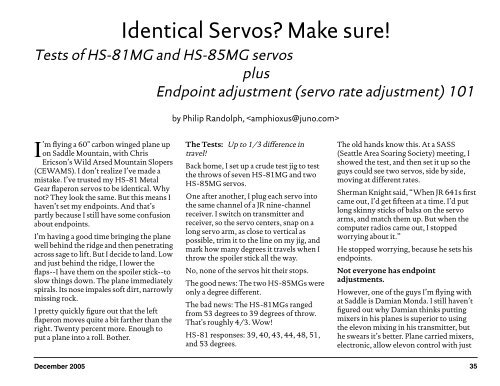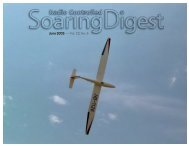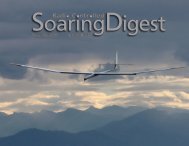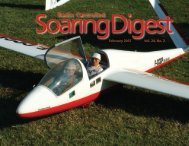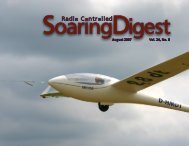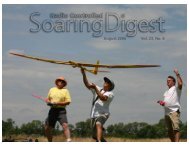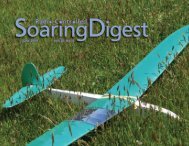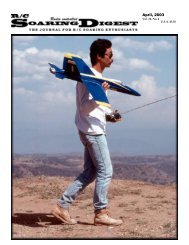December 2005 — Vol. 22, No. 12 - RC Soaring - RCSoaring.com
December 2005 — Vol. 22, No. 12 - RC Soaring - RCSoaring.com
December 2005 — Vol. 22, No. 12 - RC Soaring - RCSoaring.com
You also want an ePaper? Increase the reach of your titles
YUMPU automatically turns print PDFs into web optimized ePapers that Google loves.
Identical Servos? Make sure!<br />
Tests of HS-81MG and HS-85MG servos<br />
plus<br />
Endpoint adjustment (servo rate adjustment) 101<br />
by Philip Randolph, <br />
I<br />
’m flying a 60" carbon winged plane up<br />
on Saddle Mountain, with Chris<br />
Ericson’s Wild Arsed Mountain Slopers<br />
(CEWAMS). I don’t realize I’ve made a<br />
mistake. I’ve trusted my HS-81 Metal<br />
Gear flaperon servos to be identical. Why<br />
not? They look the same. But this means I<br />
haven’t set my endpoints. And that’s<br />
partly because I still have some confusion<br />
about endpoints.<br />
I’m having a good time bringing the plane<br />
well behind the ridge and then penetrating<br />
across sage to lift. But I decide to land. Low<br />
and just behind the ridge, I lower the<br />
flaps--I have them on the spoiler stick--to<br />
slow things down. The plane immediately<br />
spirals. Its nose impales soft dirt, narrowly<br />
missing rock.<br />
I pretty quickly figure out that the left<br />
flaperon moves quite a bit farther than the<br />
right. Twenty percent more. Enough to<br />
put a plane into a roll. Bother.<br />
The Tests: Up to 1/3 difference in<br />
travel!<br />
Back home, I set up a crude test jig to test<br />
the throws of seven HS-81MG and two<br />
HS-85MG servos.<br />
One after another, I plug each servo into<br />
the same channel of a JR nine-channel<br />
receiver. I switch on transmitter and<br />
receiver, so the servo centers, snap on a<br />
long servo arm, as close to vertical as<br />
possible, trim it to the line on my jig, and<br />
mark how many degrees it travels when I<br />
throw the spoiler stick all the way.<br />
<strong>No</strong>, none of the servos hit their stops.<br />
The good news: The two HS-85MGs were<br />
only a degree different.<br />
The bad news: The HS-81MGs ranged<br />
from 53 degrees to 39 degrees of throw.<br />
That's roughly 4/3. Wow!<br />
HS-81 responses: 39, 40, 43, 44, 48, 51,<br />
and 53 degrees.<br />
The old hands know this. At a SASS<br />
(Seattle Area <strong>Soaring</strong> Society) meeting, I<br />
showed the test, and then set it up so the<br />
guys could see two servos, side by side,<br />
moving at different rates.<br />
Sherman Knight said, “When JR 641s first<br />
came out, I’d get fifteen at a time. I’d put<br />
long skinny sticks of balsa on the servo<br />
arms, and match them up. But when the<br />
<strong>com</strong>puter radios came out, I stopped<br />
worrying about it.”<br />
He stopped worrying, because he sets his<br />
endpoints.<br />
<strong>No</strong>t everyone has endpoint<br />
adjustments.<br />
However, one of the guys I’m flying with<br />
at Saddle is Damian Monda. I still haven’t<br />
figured out why Damian thinks putting<br />
mixers in his planes is superior to using<br />
the elevon mixing in his transmitter, but<br />
he swears it’s better. Plane carried mixers,<br />
electronic, allow elevon control with just<br />
<strong>December</strong> <strong>2005</strong> 35


